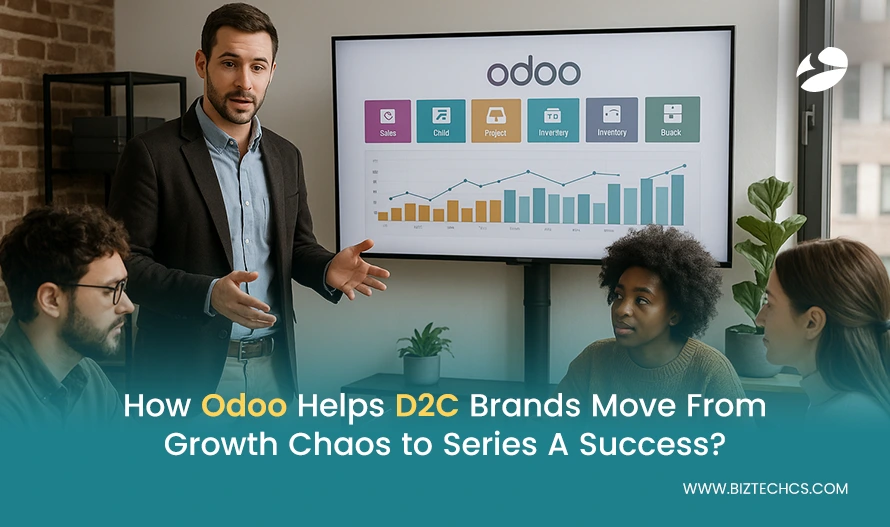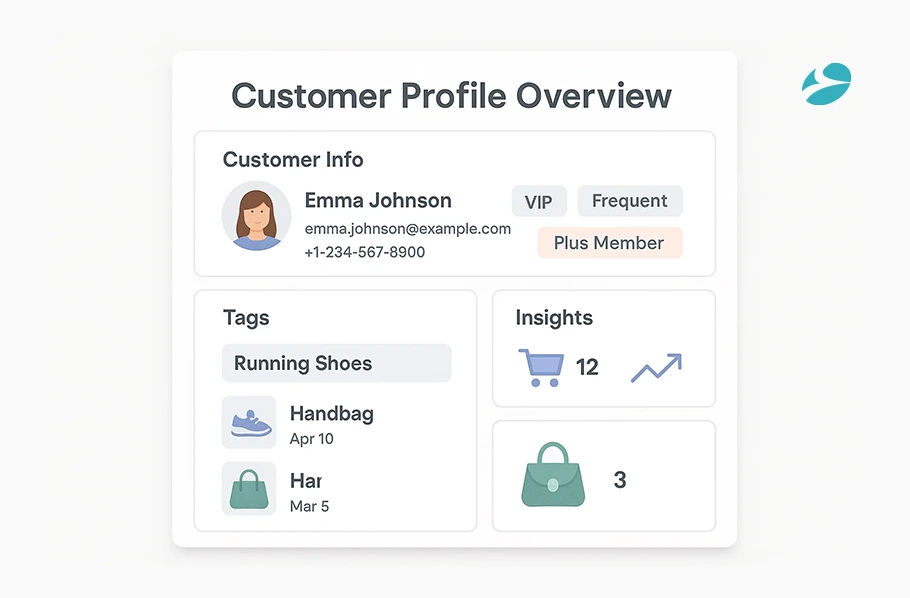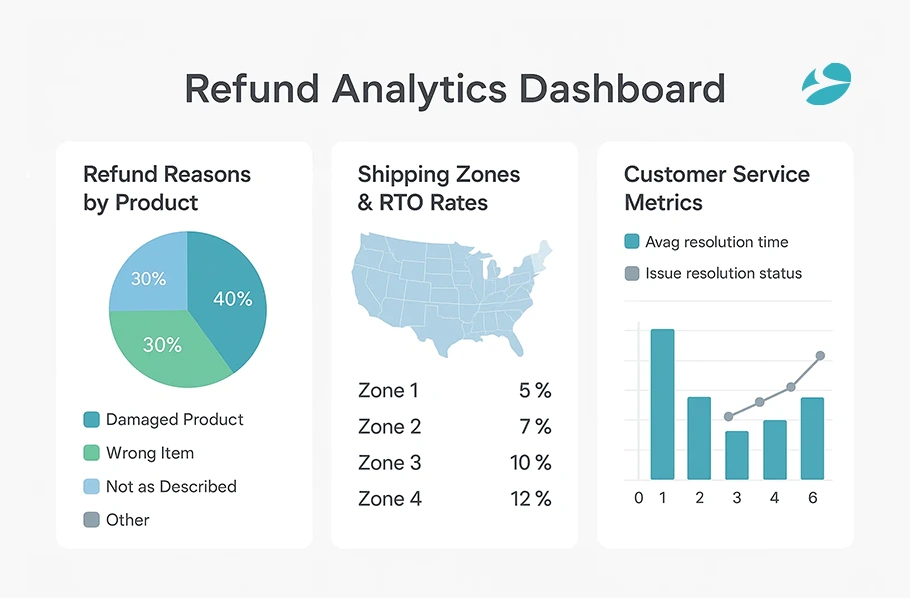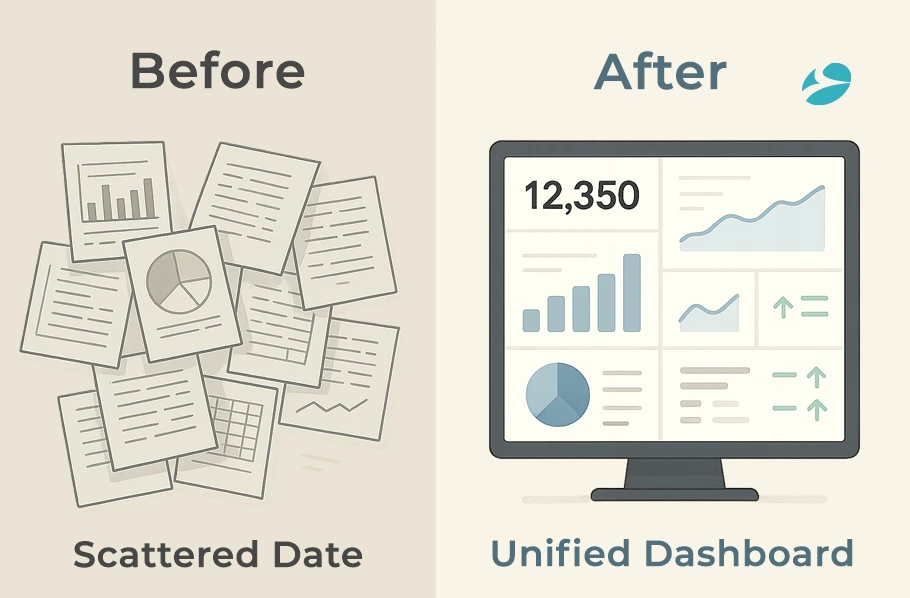66
How Odoo Helps D2C Brands Move From Growth Chaos to Series A Success?
01 Aug, 2025
5 min read
66
01 Aug, 2025
5 min read
Table of Content

Orders were skyrocketing, but so was the confusion.
Shopify showed a 300% surge in sales. Zoho CRM didn’t agree. Refunds were buried in a WhatsApp group. And late-night spreadsheet marathons had become the founder’s new normal.
For a fast-growing skincare brand in Mumbai, this was the cost of scaling without the right systems. Growth was real—but so was the chaos.
The real breaking point came when investors asked for metrics that mattered: customer acquisition cost, lifetime value, repeat purchase rates. The founder couldn’t answer with confidence.
That’s when BiztechCS stepped in with a single question:
“Can your system track first-order cohort repeat rates by channel?”
The answer changed everything.
According to a report from The Business Research Company, the banking CRM software market is estimated to grow from $18.14 billion in 2025 to $34.48 billion in 2029, at a CAGR of 17.4%. For D2C brands specifically, this fragmentation creates what we call “revenue leakage”—the silent profit killer.
Our Mumbai skincare brand was bleeding from multiple wounds:
The Shopify-CRM Disconnect: Orders lived in Shopify, but customer insights died in Zoho. When a customer called about their third purchase, support agents had no idea they were talking to a high-value repeat buyer. Every interaction started from zero.
The Attribution Black Hole: Email campaigns generated sales, but which ones? Instagram ads drove traffic, but which creatives converted to repeat buyers? Without proper attribution, their marketing budget was essentially gambling money.
The Fulfillment Fog: Tally managed fulfillment while Shopify tracked orders. When RTO rates spiked in certain pin codes, nobody could connect the dots to adjust logistics strategies.
The Head of Growth summed it up perfectly: “We’re scaling topline—but bleeding from repeat funnel blindness.”
This is exactly when BiztechCS stepped in with our signature question: “Are refund trends linked to SKU or buyer segment—or are you treating them as operational noise?” The answer revealed everything. At BiztechCS, we’ve learned that pre-Series A brands must tie every refund, complaint, and churn to product and cohort insights—your CRM becomes your investor lens, and we help you focus that lens precisely.
Here’s what most D2C brands get wrong: They think the solution is finding better ways to aggregate data from multiple systems. But aggregation is like putting bandages on a broken leg—it might stop the bleeding, but it won’t fix the underlying problem.
Gartner found that 53% of advertisers see CDPs as crucial for consistent omnichannel experiences, while 93% of marketers value CDPs for unifying fragmented customer data. This highlights the strategic importance of CDPs in business success. The key isn’t collecting more data—it’s creating a single source of truth where every customer interaction builds on the last.
This is where BiztechCS and Odoo’s unified approach creates magic. Instead of forcing your team to jump between Shopify, Zoho, WhatsApp Business, and Excel sheets, we implement one ecosystem where:
At BiztechCS, we call this our “single source of truth” methodology—before scaling spend, we help you scale insight. We’ve learned to map buyers by behavior, not just basket size, because that’s what creates sustainable growth.
After working with dozens of D2C brands preparing for Series A funding, we’ve refined our approach into three phases that minimize disruption while maximizing insight velocity.

Week 1-2: Data Migration Without Disruption We start by syncing your existing Shopify store with Odoo’s eCommerce and CRM modules. But here’s the crucial difference: We don’t just move data—we enrich it.
Every historical customer gets auto-tagged by:
Week 3-4: Attribution Architecture Remember that question about influencer codes driving the highest LTV? BiztechCS builds UTM-based campaign attribution directly into your CRM. Now when Priya from your marketing team creates an Instagram campaign, she can track not just clicks and conversions, but 90-day repeat purchase behavior.
The Immediate Impact: Within 30 days, our Mumbai brand could answer questions like:
Right now, if an investor walked into your office and asked you to show them your top 10% of customers by LTV and explain exactly how you acquired them, could you pull that report in under 5 minutes? This is the kind of investor readiness BiztechCS builds into every implementation. Our experience shows that the goal of Phase 1 isn’t perfection—it’s visibility. Once you can see your customer journey clearly, optimization becomes inevitable.

The second phase addresses what we call ‘the retention blindness’—when brands can acquire customers but can’t figure out why they leave.
Instead of treating refunds as operational noise, BiztechCS creates a refund reason code system tied directly to SKUs and customer segments. Now, every “didn’t like the fragrance” becomes data about product-market fit. Every “damaged in shipping” becomes intelligence about logistics partners in specific regions.
Our skincare brand discovered that their best-selling serum had a 23% refund rate specifically among customers aged 18-25, with the primary reason being “too strong for sensitive skin.” This BiztechCS insight led to a product line extension for sensitive skin types—and a 40% increase in repeat purchases from that demographic.
BiztechCS integrated their WhatsApp Business API with Odoo’s helpdesk module. Now when Meera from customer service receives a complaint, she sees complete order history, previous support interactions, customer’s LTV and segment, real-time shipping status, and purchase frequency patterns.
The magic happens in the context. When a high-LTV customer reports an issue, it gets priority routing. When a customer who typically orders monthly hasn’t purchased in 45 days and reports a problem, BiztechCS systems trigger a retention workflow.
RTO rates were killing margins in certain pin codes, but nobody knew which ones or why. BiztechCS built zone-wise analytics that revealed shipping partners with consistently high RTO rates and geographic clusters where customers were more likely to return products.
Armed with this data, they negotiated better rates with logistics partners and adjusted their shipping strategy to reduce RTO rates by 31% in high-risk zones.
The third phase is where technical implementation meets business strategy. Investors don’t care about how many features your CRM has—they care about unit economics, cohort behavior, and scalable growth patterns.
Dashboard Design for Due Diligence: BiztechCS built executive dashboards specifically designed for Series A conversations. CAC by Channels with real acquisition costs including hidden fees, organic allocation, and content creation costs. LTV by Cohort showing month-over-month repeat purchase behavior with refund-adjusted revenue. Channel ROI revealing which marketing investments actually drive profitable, repeat customers. And Operational Efficiency tracking fulfillment costs, RTO impact, and customer service ROI per segment.
The Cohort Story: Instead of just showing total revenue growth, these BiztechCS dashboards revealed the cohort story that investors really want to see. March 2024 customers had a 34% higher repeat rate than January 2024 customers—because they’d optimized their onboarding sequence based on CRM insights.
Real-Time Investor Answers: During investor meetings, the founder could pull up live data to answer questions like:
The founder told us, “For the first time, I felt like I was presenting facts, not hopes. The investors could see our systems working, not just our revenue growing.”
At BiztechCS, we’ve learned that investors have seen too many brands with vanity metrics and fluffy growth stories. What they’re looking for is evidence of systematic, repeatable, profitable customer acquisition and retention. Your CRM becomes your proof, and we help you present that proof convincingly. If an investor asked to see your cohort analysis by acquisition channel right now, would you have clean data ready, or would you need to “prepare something” for next week? This is exactly why BiztechCS focuses on real-time, investor-ready metrics from day one.

Within 60 days of implementation, our Mumbai skincare brand had transformed from a fast-growing but operationally chaotic startup into an insight-rich, investor-ready business:
Six months later, they successfully closed their Series-A round. The lead investor specifically mentioned their ‘sophisticated understanding of unit economics and customer behavior’ as a key factor in the investment decision.
But here’s what really mattered to the founder:
“For the first time, I felt at ease—not because we raised money, but because I finally understood our business. When growth slowed in month 8, we didn’t panic; our systems showed us exactly why it was happening and what to do next.”
This story isn’t unique. MarketsandMarkets reports that the global CDP market is expected to grow from around $9.72 billion in 2025 to over $37 billion by 2030, signaling substantial adoption among companies seeking unified customer data strategies.
In today’s D2C landscape, every brand has access to the same advertising platforms, the same influencers, and similar products. The competitive advantage isn’t in acquisition anymore—it’s in retention intelligence.
Brands that can answer “why do customers come back?” will always outperform brands that only know “how did customers find us?”
Here’s what separates successful D2C brands from those that plateau: systems that grow with them. Shopify + Zoho + WhatsApp + Excel might work at ₹50 lakhs revenue per month. At ₹5 crores? The manual processes break, the data gets messier, and growth actually becomes the enemy of profitability.
Odoo’s modular approach means your system evolves with your business. Need manufacturing management for your private label expansion? Add the MRP module. Ready for international expansion? The multi-currency and tax management features are already integrated. Planning subscription box offerings? The subscription management flows seamlessly with your existing customer data.
From an investor perspective, D2C brands with mature, integrated systems represent lower risk and higher potential returns. They’re not just buying your current revenue—they’re buying your ability to scale that revenue predictably.
Image Prompt: Growth trajectory chart showing two lines – one representing traditional fragmented systems plateauing, another showing integrated systems continuing to scale exponentially
Thinking about your own scalability? Let’s explore how an integrated approach could position your brand not just for the next quarter, but for the next funding round.
Ready to transform your D2C operations? Here’s how to think about your Odoo implementation timeline:
The BiztechCS Difference What makes our approach different is the focus on business outcomes, not just technical implementation. Every feature we set up is designed to answer a specific business question or solve a specific operational challenge.
We don’t just migrate your data—we structure it for insights. We don’t just connect your systems—we create workflows that drive behavior. We don’t just build dashboards—we design them for decision-making.
1. Integration Beats Aggregation Don’t try to make disconnected systems work better together. Build one system that does everything well.
2. Customer Data Is Your Competitive Moat In a world where everyone has access to the same acquisition channels, customer intelligence becomes your sustainable advantage.
3. Series A Readiness Requires Real-Time Metrics Investors want to see systems working, not just results happening. Your CRM should be able to answer any unit economics question in real-time.
4. Retention Intelligence Drives Profitable Growth Understanding why customers come back is more valuable than knowing how they found you.
5. Systems Should Evolve With Your Business Choose platforms that can grow with you rather than forcing you to migrate every 18 months.
Every D2C brand reaches a point where growth reveals the cracks in their operational foundation. The question isn’t whether you need integrated systems—it’s whether you’ll address it proactively or reactively.
BiztechCS has helped dozens of D2C brands navigate this transformation, from early-stage startups preparing for their first funding round to established brands scaling for international expansion.
If this story resonates with your current challenges, let’s explore what a unified customer intelligence platform could look like for your brand. We’d love to understand your specific growth stage, operational challenges, and Series A timeline.
The transformation doesn’t happen overnight, but it starts with a single decision: choosing systems over spreadsheets, integration over isolation, and insights over assumptions.
All product and company names are trademarks™, registered® or copyright© trademarks of their respective holders. Use of them does not imply any affiliation with or endorsement by them.

68
By Biztech
09 Oct, 2025

74
By Biztech
09 Oct, 2025

91
By Biztech
06 Oct, 2025